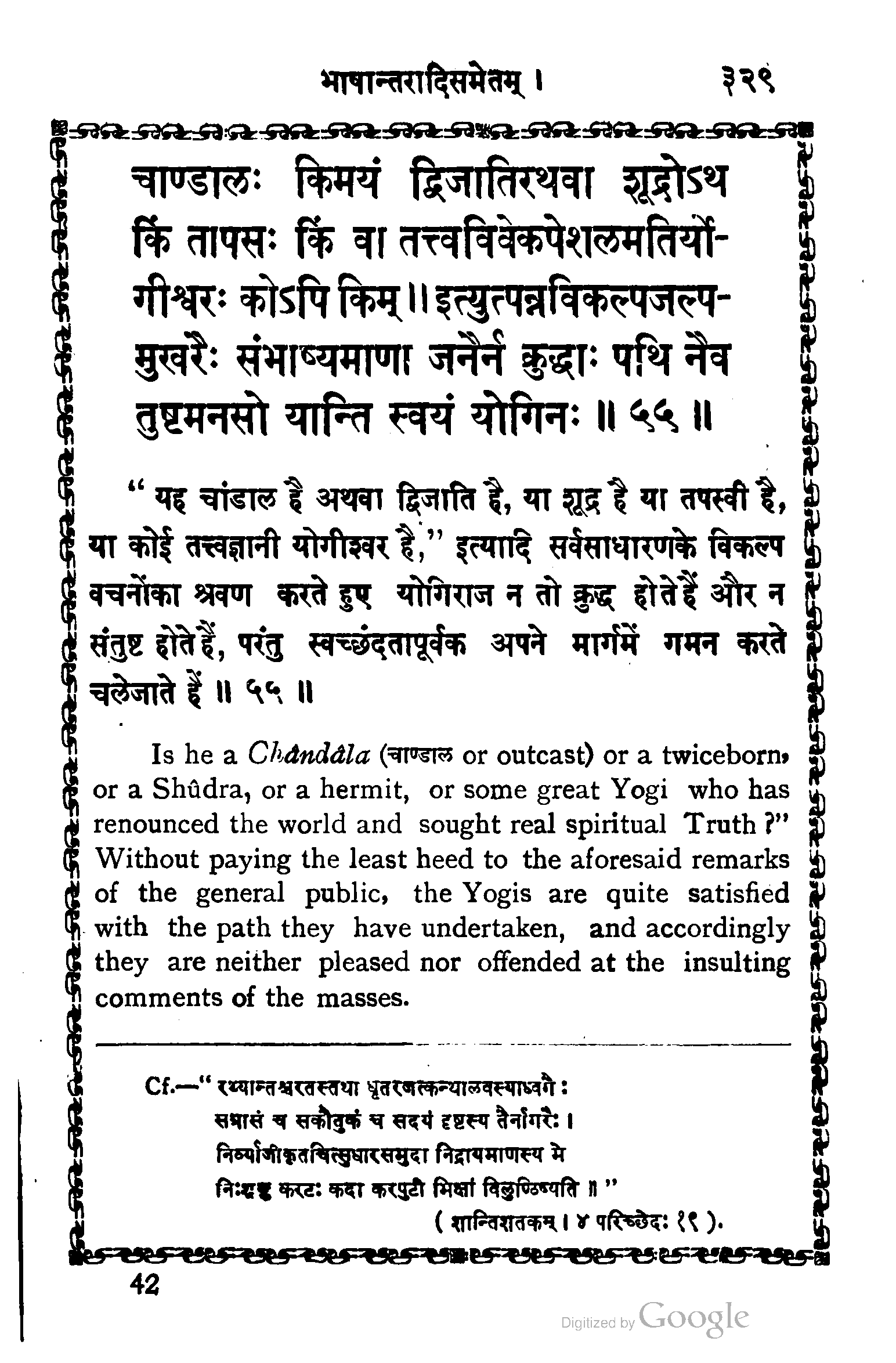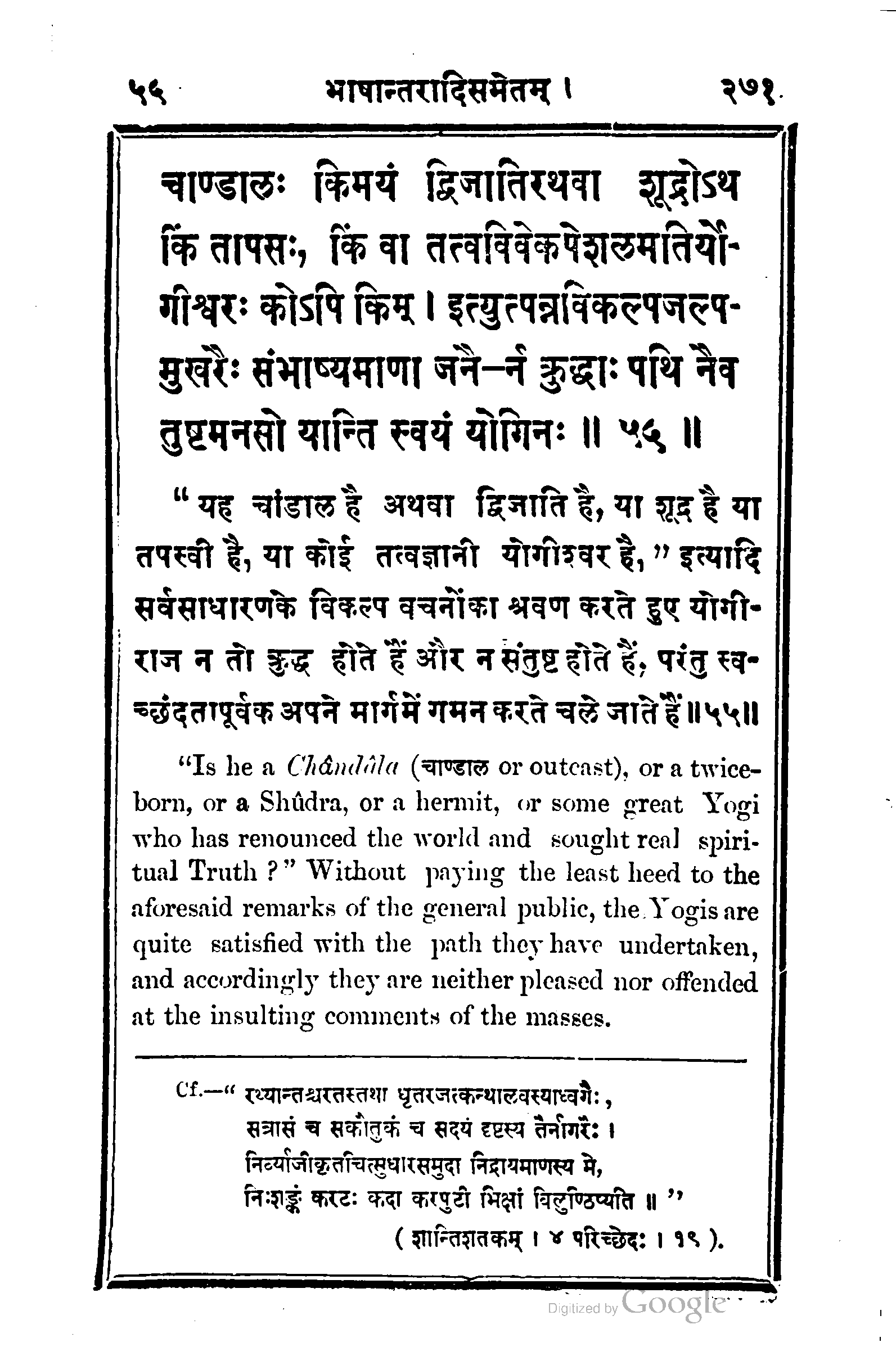Ryder
Tawney
Mādhavānanda
Telang
verse

Text (not proofread)
चाण्डाल : किमयं द्विजातिरथवा शूद्रोय किं तापस :
किंवा तत्त्वनिवेशपेशलमतिर्योगीश्वरः कोपि किम् ।
इत्युत्पन्न विकल्प जल्पमुखरैः संभाष्यमाणा जनै
नै क्रुद्धाः पथि पथि नैव नैव तुष्टमनसो यान्ति स्वयं योगिनः ॥ ५६ ॥
footnote

Text (not proofread)
LVI ( a ) चा ० ; च ° I. P. R. Bo . n . किम् ; वा A. ( 6 ) ० निवेश ;
विवेक ° B. किम ; वा . M. IT . ( 0 ) ०३ : सम् ॰; ०३ ° A. N. ०० ; व्य
B. T. P. R. ० णा ; ० णो . A. ० ना . B. T. P. B. नैर्न ° ; ° नो नो ° A. ° ने .
नों Bo.n. ( d ) यान्ति स्वयम् ; यस्यन्ति ● ते . M.
endnote

Text (not proofread)
St. LVI . --तस & c . = तत्त्वनिवेशन तसज्ञानेन वैशला सुकुमारा करुणाद्री म
faĝtzien a amya : ( Râmarshi ) better , I think " one whose mind
is skilled in concentration on the truth . " Tin Gitâ II . , 16 is
explained by S'ankara as and by S'ridhara as
which two are not inconsistent . That meaning may be
adopted here ; for T comp . Misc . St. 19. = clever .
& c . - उत्पन्ना उदिता विकल्पजन्यः वितर्कवचनानि येषां ते उत्पन्नविकल्पजसा भत
v gut : çâu : ( Råmarshi . ) ; better , I think , : as in Nitis'à
taka St. 69. स्वयम् = स्खेनैव रूपेण भानन्दवन्त इत्यर्थः ( Ramarshi ) but
" by themselves " is , I think , quite admissible . - S'árdúlavikríḍita .
Kosambi
verse


Text (not proofread)
चण्डालः किमयं द्विजातिरथ वा शूद्रोऽथ किं तापसः
किं वा तत्त्वनिवेशपेशलमतिर्योगीश्वरः कोऽपि किम् ।
इत्युत्पन्नविकल्प जल्पमुखरैः संभाष्यमाणा जनैर्
न क्रुद्धाः पथि नैव तुष्टमनसो यान्ति स्वयं योगिनः ॥ २४३ ॥
footnote


Text (not proofread)
243 { V } Om . in W. Y7 missing . - a ) Ait 2 Ba Eo . 5 IF +5 Y3 चांडाल : ; J3
जंडाल : B1 Gst किमथ 32 शूरोथ ; F1 J2 शूद्रोपि ; Y० शुद्रो न . BFXY2 G1 - 3
M1.2.45 वां ( for किं ) . G० वा कोपि वा ; Ms वैश्योथ वा ( for किं तापस :) . – 2 0 ) Gs कं ( for
किं ) . B -निविष्ट ; C -विशेष ; Y ( Y7 missing ) I'in - विवेक ( for -निवेश ) . B H3t -निर्मल
( for -पेशल- ) , Yint पटुर् ( for - मतिर् ) . B कोप्यहो ; Do Ja Ma 5 कोपि वा ; Ga M1.2
कश्चन ( for कोऽपि किम् ) . – " ) 133 विवेक ( for -विकल्प - ) . A0 - 2 - जाल ; D मोह- ; Gat
पक्ष- ( for जल्प - ) . A02 F1 + H संभाव्यमाना ( He.v.se.vas in toxt ) ; D F2 J X
Y1.3–6.4 T G2.4.5 M3 आभाष्यमाणा ( IF 2 Y : T2 णो ; J3 णैर् ; T3 ' णं ) ; E3.4 F3 M1 . 2
संभाव्यमाणो ( 1234 नो ) ; X 2 आकीर्यमाणो ; ( | आकृष्यमाणा . F2 J1 जनो ( for जनैर् ) . ) a
12. 5 Y 2 नो ; Y3 सं- ( for न ) . 12 क्रुहो ; Xe क्रुद्धः . 1 ) पथि चैव ; M4 पथिकैः सु . C हृष्ट
( for तुष्ट - ) . A3 गच्छंति ते ; Do ( m.v. as in text ) .5 and lie यास्यंति ते .
$
BIS . 2225 ( 889 ) Bhartr . lith ed . I. 3. 95 , 1I . 51. Galan 91 Schiefner and
Weber . p . 24 , Subhāsh . 284 ; SM . 910 ; SSV . 802 ; SS.D. 4. f . 26 .

